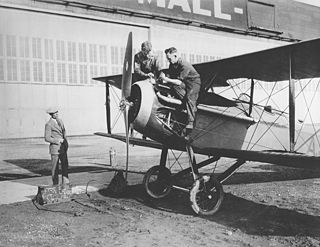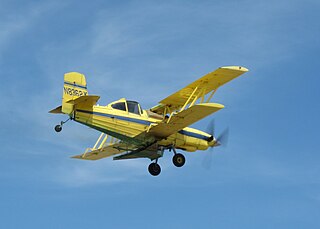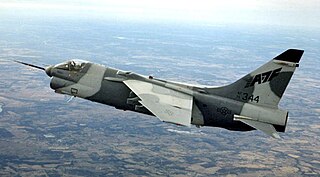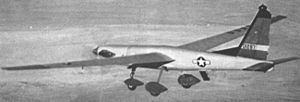
The McDonnell XF-88 Voodoo was a long-range, twinjet fighter aircraft with swept wings designed for the United States Air Force. Although it never entered production, its design was adapted for the subsequent supersonic F-101 Voodoo.

The LTV A-7 Corsair II is an American carrier-capable subsonic light attack aircraft designed and manufactured by Ling-Temco-Vought (LTV).

The Sikorsky Cypher and Cypher II are types of unmanned aerial vehicles developed by Sikorsky Aircraft. They are vertical takeoff and landing aircraft which use two opposing rotors enclosed in a circular shroud for propulsion.

Vought was the name of several related American aerospace firms. These have included, in the past, Lewis and Vought Corporation, Chance Vought, Vought-Sikorsky, LTV Aerospace, Vought Aircraft Companies, and Vought Aircraft Industries. The first incarnation of Vought was established by Chance M. Vought and Birdseye Lewis in 1917. In 1928, it was acquired by United Aircraft and Transport Corporation, which a few years later became United Aircraft Corporation; this was the first of many reorganizations and buyouts. During the 1920s and 1930s, Vought Aircraft and Chance Vought specialized in carrier-based aircraft for the United States Navy, by far its biggest customer. Chance Vought produced thousands of planes during World War II, including the F4U Corsair. Vought became independent again in 1954, and was purchased by Ling-Temco-Vought (LTV) in 1961. The company designed and produced a variety of planes and missiles throughout the Cold War. Vought was sold from LTV and owned in various degrees by the Carlyle Group and Northrop Grumman in the early 1990s. It was then fully bought by Carlyle, renamed Vought Aircraft Industries, with headquarters in Dallas, Texas. In June 2010, the Carlyle Group sold Vought to the Triumph Group.
Ling-Temco-Vought (LTV) was a large US conglomerate which existed from 1961 to 2000. At its peak, it was involved in aerospace, airlines, electronics, steel manufacturing, sporting goods, meat packing, car rentals, and pharmaceuticals, among other businesses.

The Dassault Mirage G was a French two-seat twinjet variable-geometry prototype fighter, built by Dassault Aviation in the late 1960s. The type was further developed into the twin-engine Mirage G4 and G8 variants as a multi-role jet fighter capable of both interception and nuclear strike missions. Although Dassault built and flew prototypes, the entire programme was terminated in the 1970s without the aircraft entering production.

The X-26 Frigate is the longest-lived of the X-plane programs. The program included the X-26A Frigate sailplane and the motorized X-26B Quiet Thruster versions: QT-2, QT-2PC, and QT-2PCII. All were based on the Schweizer SGS 2-32 sailplane.

The Bréguet Br 960 Vultur was a prototype two-seat carrier-based attack and anti-submarine aircraft (ASW) built for the French Navy during the early 1950s. Meeting contradictory endurance and speed requirements, it was designed as a "mixed-power" aircraft with a turboprop engine in the front and a turbojet in the rear. Only two examples were built, but the second aircraft was rebuilt as the prototype of the Bréguet 1050 Alizé ASW aircraft after the Navy dropped the idea of a turboprop attack aircraft in the mid-1950s.

The Grumman G-164 Ag Cat is a single-engine biplane agricultural aircraft, developed by Grumman in the 1950s.
The history of unmanned combat aerial vehicles (UCAVs) is closely tied to the general history of unmanned aerial vehicles (UAVs).

The Texas Engineering & Manufacturing Company (TEMCO), also known as Temco Aircraft Corporation, was a U.S.-based manufacturing company located in Dallas, Texas, USA. It is best known for eventually forming part of the conglomerate Ling-Temco-Vought.

The Ling-Temco-Vought (LTV) XC-142 was a tri-service tiltwing experimental aircraft designed to investigate the operational suitability of vertical/short takeoff and landing (V/STOL) transports. An XC-142A first flew conventionally on 29 September 1964, and on 11 January 1965, it completed its first transitional flight by taking off vertically, changing to forward flight and finally landing vertically. Its service sponsors pulled out of the program one by one, and it eventually ended due to a lack of interest after demonstrating its capabilities successfully.

The Schweizer SGS 2-32 is an American two-seat, mid-wing, two or three-place glider built by Schweizer Aircraft of Elmira, New York.
The Martin Marietta Model 845 was a remotely piloted aircraft developed in the United States in the late 1960s and early 1970s for use as a communications relay in the Vietnam War.

The BAE Systems Mantis Unmanned Autonomous System Advanced Concept Technology Demonstrator is a British demonstrator programme for Unmanned Combat Air Vehicle (UCAV) technology. The Mantis is a twin-engine, turboprop-powered UCAV with a wingspan of approximately 22 m, broadly comparable to the MQ-9 Reaper. Other partners involved in Phase 1 of the Mantis programme include the Ministry of Defence, Rolls-Royce, QinetiQ, GE Aviation, L-3 Wescam, Meggitt and Lola.

The DRDO Rustom is a Medium Altitude Long Endurance unmanned air vehicle (UAV) being developed by Defence Research and Development Organisation for the three services, Indian Army, Indian Navy and the Indian Air Force of the Indian Armed Forces. Rustom is derived from the NAL's LCRA developed by a team under the leadership of late Prof Rustom Damania in the 1980s. The UAV will have structural changes and a new engine. Rustom will replace/supplement the Heron UAVs in service with the Indian armed forces.

The Frontiers of Flight Museum is an aerospace museum located in Dallas, Texas, founded in November 1988 by William E. Cooper, Kay Bailey Hutchison, and Jan Collmer. Originally located within a terminal at Dallas Love Field, the museum now occupies a 100,000-square-foot (9,300 m2) building at the southeast corner of Love Field on Lemmon Avenue. The museum is an affiliate within the Smithsonian Affiliations program.

The Vought YA-7F "Strikefighter" is a prototype transonic attack aircraft based on the subsonic A-7 Corsair II. Two prototypes were converted from A-7Ds. The YA-7F was not ordered into production, its intended role being filled by the F-16 Fighting Falcon.

The LTV L450F, also known as the L45ØF, was a prototype quiet reconnaissance aircraft, developed by Ling-Temco-Vought in the late 1960s for use in the Vietnam War by the United States. Based on the airframe of a Schweizer 2-32 sailplane, the aircraft flew in 1970, and was developed into the XQM-93 reconnaissance drone before the project was cancelled.

The Lockheed L-1249 Super Constellation was a turboprop-powered version of the Lockheed Constellation aircraft family. Built in 1954 and 1955, the aircraft were used as prototypes for possible future military transport aircraft for both the United States Air Force and United States Navy. Both aircraft saw very short lives and the airframes were later used to build L-1049 Super Constellations.


















